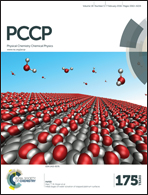An extended DFTB-CI model for charge-transfer excited states in cationic molecular clusters: model studies versus ab initio calculations in small PAH clusters
Abstract
We present an extension of the constrained density functional tight binding scheme combined with configuration interaction (DFTB-CI) to efficiently compute excited states of molecular cluster cations and their oscillator strengths from the ground state. The present extension consists of generalizing the initial model, relying on configurations with holes in the monomer HOMOs only, to configurations involving sub-HOMO holes, allowing for the description of higher excited states. The extended scheme is benchmarked on selected energy pathways with respect to available ab initio and new CASPT2 reference calculations on the benzene, naphthalene and pyrene dimer cations. The ability of the model to describe the potential energy surfaces and the transition dipole moments is discussed. The vertical electronic absorption spectra of the three dimer cations are calculated and compared with the theoretical litterature and available experimental data. Finally, the electronic absorption spectra of low energy isomers of the trimer and tetramer pyrene cluster cations are also predicted.


 Please wait while we load your content...
Please wait while we load your content...